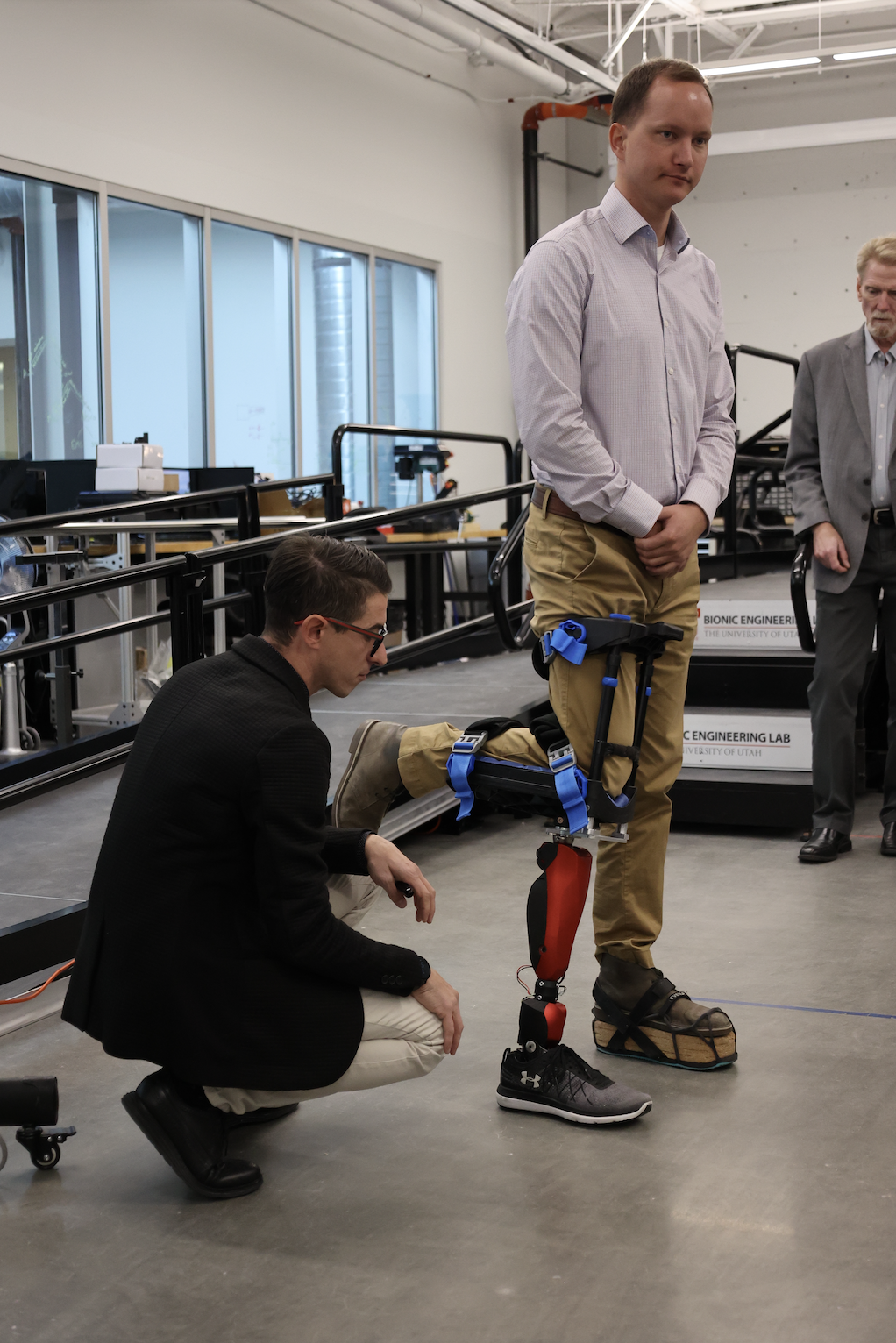By Bubba Brown
An Apple headset that the company hopes will revolutionize virtual reality. A supercomputer developed by Hewlett Packard Enterprise that is seen as a first-of-its-kind technological marvel. A supersonic jet engineered by Lockheed Martin and NASA that produces a sonic boom no louder than a car door being shut.
Alongside these creations dreamed up by some of the world’s most illustrious innovators: the Utah Bionic Leg, a motorized prosthetic designed by a RMCOEH faculty member that carries the potential of reshaping the lives of millions of lower-limb amputees worldwide.
The bionic leg and the other three works were among 200 innovations that TIME magazine deemed worthy of inclusion in its recent “Best Inventions of 2023” list, a compilation of technologies and developments that the publication says are “changing how we live.”
Tommaso Lenzi, PhD, a professor within the University of Utah’s Department of Mechanical Engineering and the director of RMCOEH’s Ergonomics and Safety program, has led the development of the bionic leg. A number of RMCOEH students, as well as other students within the Department of Mechanical Engineering, have also contributed to the project, as well as Lenzi’s other bionics research.

Tommaso Lenzi, left, the director of RMCOEH’s Ergonomics
and Safety program, and postdoctoral trainee Lukas Gabert
demonstrate the Utah Bionic Leg. The bionic leg, which aims
to improve mobility for lower-limb amputees, was recently
included in TIME magazine’s “Best Inventions of 2023” list.
Photo: Charlie Schuknecht
Lenzi said it is gratifying for the prosthetic to gain placement on a list populated with inventions developed by the likes of Apple, NASA, and other technological titans.
“This is quite an honor,” he said. “We are passionate about this project because we know it has massive potential to improve the lives of amputees. It’s terrific to see that others share in that vision, and we’re excited to continue working toward making it a reality.”
The design that makes the bionic leg unique involves motors, processors, and advanced artificial intelligence, which allow it to function much more like a natural leg than a traditional prosthetic. It helps amputees walk, stand up, sit down, and go up and down stairs — functions that many people take for granted but that can inhibit the ability of those who have lost a leg to lead mobile, fully autonomous lives.
The leg and other bionic technologies Lenzi and his team are developing, including powered knee and hip exoskeletons, have significant applications within occupational safety and health. For instance, the devices could enable people with debilitating health issues that limit their mobility, such as stroke survivors, to reenter the workforce.
“Working on this project is really exciting, both because it is a stimulating challenge and because the sense of purpose is so strong,” said Lukas Gabert, a postdoctoral trainee in RMCOEH’s Ergonomics and Safety program who has played a pivotal role in the bionic leg’s development. “We know we have a chance to make a difference in people’s lives.”
The bionic leg is not yet a finished product. Lenzi and his team are conducting additional testing and have not received FDA approval for the device. But so promising is the technology that Ottobock, a German firm considered to be the world leader in prosthetics, licensed the technology that makes the bionic leg possible last year, agreeing to co-develop the robotic prostheses for lower-limb amputees.
“As a health-tech champion, Ottobock always seeks to improve functionality and safety for patients and users worldwide,” said Hans Georg Näder, owner and board chairman of Ottobock, when the agreement was announced in October 2022. “Professor Lenzi’s technology promises to achieve exactly that. It is a superior prosthetic knee, incomparable to any currently available product.”
Inclusion on TIME’s list is not the first time the bionic leg has received national recognition. Last fall, it was featured on the cover of Science Robotics, a prominent journal within the field of robotics. The issue included a peer-reviewed article authored by Lenzi, Gabert, and two graduate students.
“We are proud of our progress on the Utah Bionic Leg thus far,” Lenzi said. “But there is still much work to be done. The importance of our mission is something we don’t take lightly.”



 © 2026 Rocky Mountain Center for Occupational and Environmental Health
© 2026 Rocky Mountain Center for Occupational and Environmental Health